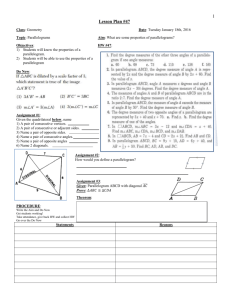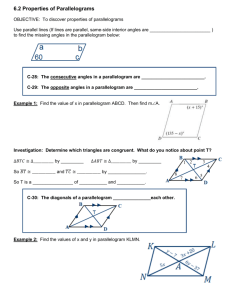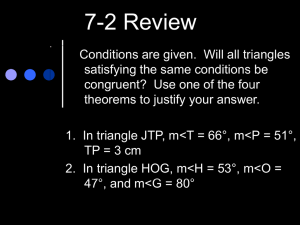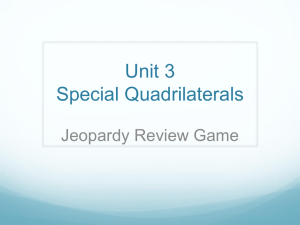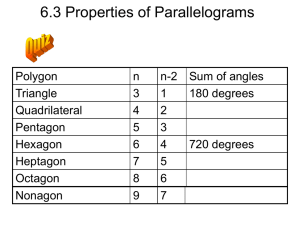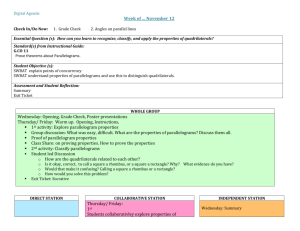6-2 Properties of Parallelograms
advertisement
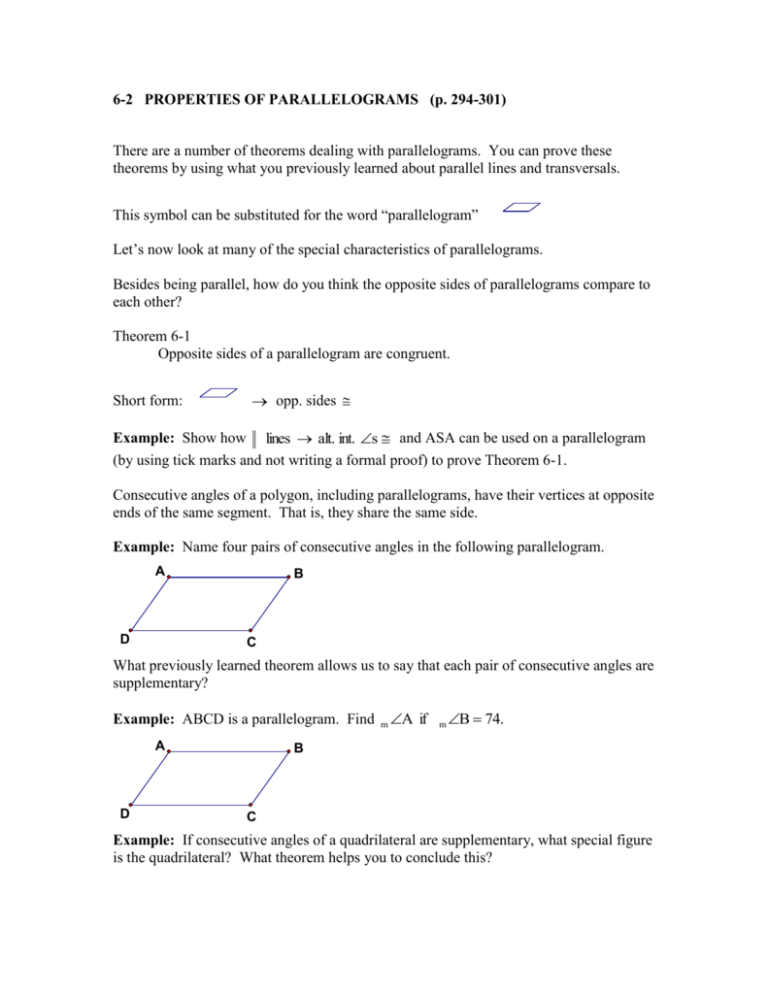
6-2 PROPERTIES OF PARALLELOGRAMS (p. 294-301) There are a number of theorems dealing with parallelograms. You can prove these theorems by using what you previously learned about parallel lines and transversals. This symbol can be substituted for the word “parallelogram” Let’s now look at many of the special characteristics of parallelograms. Besides being parallel, how do you think the opposite sides of parallelograms compare to each other? Theorem 6-1 Opposite sides of a parallelogram are congruent. Short form: opp. sides Example: Show how lines alt. int. s and ASA can be used on a parallelogram (by using tick marks and not writing a formal proof) to prove Theorem 6-1. Consecutive angles of a polygon, including parallelograms, have their vertices at opposite ends of the same segment. That is, they share the same side. Example: Name four pairs of consecutive angles in the following parallelogram. A D B C What previously learned theorem allows us to say that each pair of consecutive angles are supplementary? Example: ABCD is a parallelogram. Find A D m A if m B 74. B C Example: If consecutive angles of a quadrilateral are supplementary, what special figure is the quadrilateral? What theorem helps you to conclude this? The angles directly across from each other in a parallelogram are called opposite angles. Example: Name the two pairs of opposite angles in the following parallelogram. A D B C How do you think opposite angles compare to each other? Theorem 6-2 Opposite angles of a parallelogram are congruent. Short form: opp. s You will prove this theorem as homework problem #38. The previously learned theorem, supplements of the same angle are congruent, will be a key step in the proof of Theorem 6-2. There are many excellent algebra problems involving parallelograms. Example: In parallelogram JKLM, JK 8x - 17 and LM 4x 32. Set up and solve an equation to find x, JK, and LM. J M K L Do 2 on p. 295. Example: Name the diagonals in parallelogram JKLM. Are they always congruent? Are they always perpendicular? What do you think the diagonals do to each other? J M K L Theorem 6-3 The diagonals of a parallelogram bisect each other. Short form: bisecting diagonals. Example: Use the following figure to prove Theorem 6-3 (use tick marks and do not write a formal proof). Use a pair of congruent triangles in your proof. J K 1 4 E 3 M 2 L Example: KLMN is a parallelogram. Also, KA 2x 5, AM 5y, LA x, and AN 7y - 16. Find the values of x and y in the figure by solving a system of linear equations. K L A N M Do 3 on p. 296. The proof for the next theorem is rather lengthy. You will prove it as homework problem #55. All of the statements will be given. Theorem 6-4 If three or more parallel lines cut off (or form) congruent segments along one transversal, then they cut off congruent segments on every transversal. A Z W X Y T J K L M B Example: According to Theorem 6-4, if ZW WX XY , how do JK , KL, and LM compare to each other? Does this mean ZW JK ? How does JL compare to JK? How does ZY compare to WX? Do 4 on p. 297. Homework p. 297-301: 4,9,11,14,16,21,22,27,32,35,38,43,50,53,55,71,74 35. Solve x x 2x 7 2x 7 92 6x 78 13 cm, 13 cm, 33 cm, 33 cm x 13
